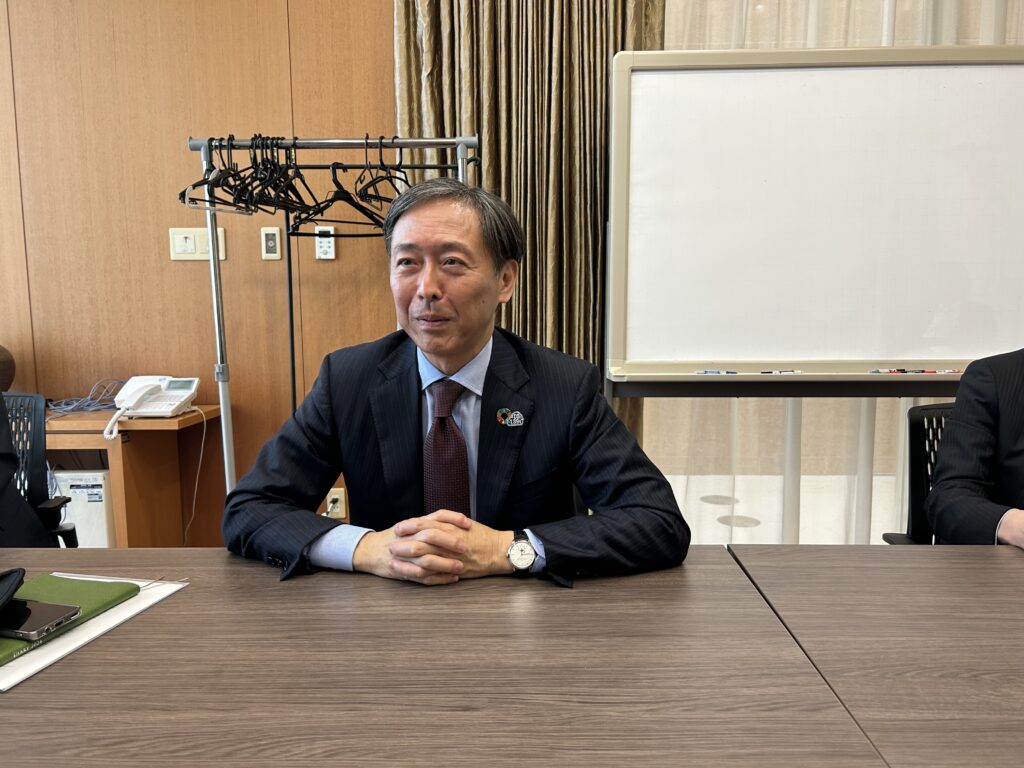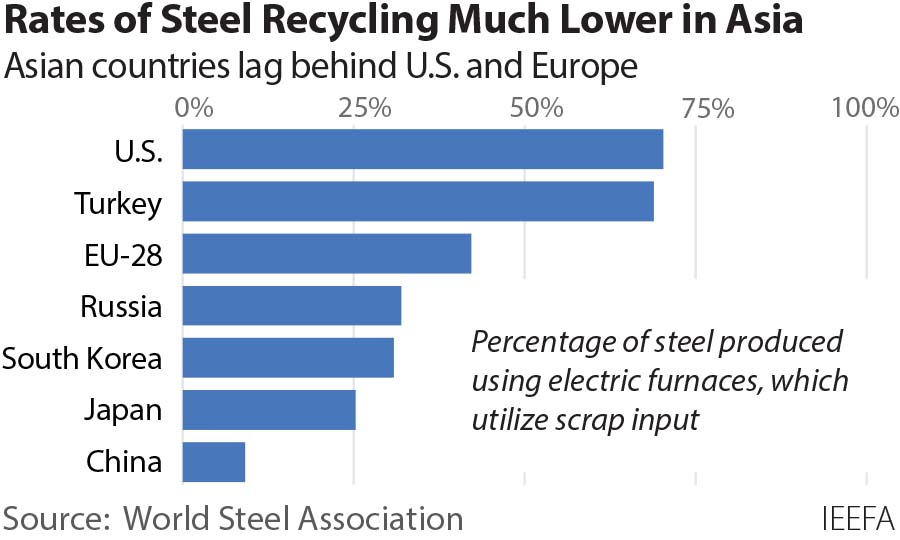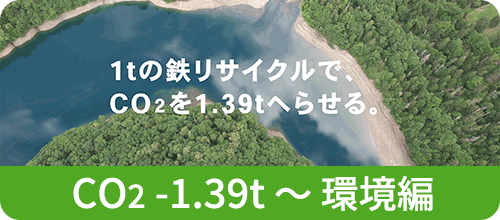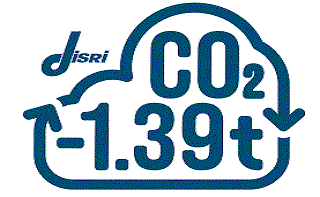
〆In a recent interview, Kensuke Kitani, the Chairperson of the Japan Iron and Steel Recycling Institute (JISR), shared his insights on the future of the iron scrap industry.
〆”Shortly, iron scrap will become a highly sought-after resource worldwide,” Kitani stated.
〆He emphasized the growing importance of iron scrap as a critical resource and predicted global competition for it in the coming years.
(Text by Hirofumi Yamamoto)
Since its establishment in 1975, the Japan Iron and Steel Recycling Institute (JISR) has been at the forefront of iron scrap recycling, driven by the goal of preserving the global environment. As of April, JISR boasts 699 regular members (683 dedicated recycling companies, 15 trading companies, and 1 overseas company), 167 registered business locations (131 dedicated recycling companies and 36 trading companies), and 90 supporting members encompassing 115 business locations. Notably, in the past two years, 55 companies, primarily from the blast furnace manufacturing sector, have joined as supporting members.
In a recent interview, Kensuke Kitani, President of SHIMABUN Corporation and Chairperson of JISR, shared his views on the current state of iron scrap recycling in Japan. “Ships will play a crucial role in meeting future iron scrap demand,” Kitani stated.
(Text by Hirofumi Yamamoto)

■Impact of the Carbon Neutral (CN) Announcement
Yamamoto: In October 2020, Prime Minister Suga announced Japan’s goal to achieve carbon neutrality by 2050. What impact does this have on the iron and steel recycling industry?
Kitani: “This decision has significant implications for the iron and steel recycling industry. Achieving carbon neutrality by 2050 may seem like a distant goal, but when we examine the roadmap in detail, we realize that steel manufacturers must reduce CO2 emissions by 30% compared to 2013 levels by 2030. That’s just six years away. I believe that if we do not take action now, we will not meet the 2050 net-zero CO2 goal.”
Yamamoto: Specifically, what role does JISR see itself playing in achieving net-zero emissions by 2050?
Kitani: “Japan’s steel manufacturers are pursuing various technological developments to meet their targets. One of these is using direct reduced iron and hydrogen reduction steelmaking. Hydrogen reduction, in particular, emits almost no CO2. However, whether this technology can be realized depends not only on the technological development itself but also on external factors.”
Kitani: “The steel industry’s efforts are similar to the maritime industry’s research on new fuel technologies. Therefore, I believe that, with current technology, converting from blast furnaces to electric furnaces is one of the few ways to reduce CO2 emissions. From a practical perspective, the shift to electric furnaces will become more pronounced in the future. At that time, it will be crucial for the recycling industry to supply high-quality scrap.”

■Transition to Electric Arc Furnaces
Yamamoto: Can Japan secure enough domestic steel scrap to fuel the large electric arc furnaces (EAF) planned by Nippon Steel and JFE Steel?**
Kitani: “The Japan Ferrous Raw Materials Association reported that the demand for steel scrap in 2023 was 37.95 million tons. Of this, 8.66 million tons were used in blast furnaces (converters), 24.10 million tons in electric arc furnaces, and 5.19 million tons in foundries and other uses. To meet our CO2 reduction targets, we have projected the production volumes for both blast furnaces and electric arc furnaces, and analyzed the demand trends for steel scrap.”
Yamamoto: Can you provide more specific details?
Kitani: “In summary, to achieve a 30% reduction in CO2 emissions by fiscal year 2030 compared to fiscal year 2013, we will face a shortage of 12 million tons of steel scrap.”
“The assumptions for our projections are as follows: If the crude steel production in fiscal year 2030 is set at 98 million tons, the same level as fiscal year 2019, the production of crude steel from electric arc furnaces will increase by 22 million tons. Although this is a straightforward calculation, it is practically impossible for Japan to import the relatively high-quality 12 million tons of steel scrap needed from overseas.”
Yamamoto: So, what is the solution?
Kitani: “Japan has consistently been an importer of steel scrap since before the war. It was only in the 1990s that we had a surplus and became an exporter. Given the rising global demand for steel scrap, relying on imports is highly risky.”
“Therefore, we calculated the volume of crude steel production that would allow us to meet the 30% CO2 reduction target by fiscal year 2030 while maintaining a net zero import-export balance for steel scrap.”
“In conclusion, with a crude steel production volume of 90 million tons, comprising 56 million tons from blast furnaces (with an iron ore import volume of 89 million tons) and 34 million tons from electric arc furnaces, we could meet the domestic demand for steel scrap. However, there will likely still be a mismatch in grades, meaning that we will continue to export low-grade scrap and import high-grade scrap.”

■ Producing High-Grade Steel with Electric Arc Furnaces
Yamamoto: Even if CO2 emissions can be reduced if high-grade steel sheets for automobiles and thick plates for shipbuilding cannot be produced with electric arc furnaces (EAF), there will be a mismatch in the steel manufacturers’ products.**
KItani: “Exactly. That is why we need high-grade steel scrap that is ideal for electric arc furnaces. It will be difficult to secure this solely through the efforts of private companies. The Japanese government needs to take the lead in implementing measures such as promoting the dismantling of idle facilities in the country to utilize currently unused steel sources. Additionally, we are focusing on Japan’s status as one of the world’s leading maritime nations.”
“Ocean-going vessels built at Japanese shipyards use a large amount of high-quality Japanese steel. By dismantling ships at the end of their life cycle in Japan, we can secure high-grade steel scrap. From the perspective of scrap companies, large cargo ships are almost entirely made of steel, allowing for the collection and utilization of high-quality steel scrap without the need for detailed disassembly as with automobiles.”
Yamamoto: What are your expectations for ship scrap from the perspective of the Japan Iron and Steel Recycling Institute (JISRI)?**
KItani: “There will be challenges such as costs, labor, and suitable locations. However, a global scramble for steel scrap is imminent. From the perspective of Japan’s economic security, ship scrap from the Japanese merchant fleet is an extremely important resource. As the demand for high-grade steel scrap continues to increase, we believe it is time to seriously consider domestic ship dismantling.”
■Biography of Kensuke Kitani
Kensuke Kitani graduated from the University of Tokyo’s Faculty of Economics in 1990. In the same year, he joined Nippon Steel Corporation (now Nippon Steel). He joined SHIMABUN CORPORATION in 2005. After serving as the Head of the Kansai Branch and Vice President, he has been in his current position since 2022. He was born in Tokyo and is 58 years old.

Photo courtesy =JISR, IEEFA
〆船舶スクラップが日本を救う(Series 3)
日本鉄リサイクル工業会(Japan Iron and Steel Recycling Institute ; 略称: JISR)の木谷謙介(Kensuke Kitani)会長にインタビューする。「近い将来、鉄スクラップは世界で争奪戦になる」
日本鉄リサイクル工業会(Japan Iron and Steel Recycling Institute ; 略称: JISR)は1975年に設立以来、地球環境保全という目標に向けて鉄スクラップのリサイクルの中心となってきた。4月時点で会員は正会員699社(専業683、商社15、海外1)、登録事業所167事業所(専業131、商社36)、賛助会員90社115事業所で構成されている。特に最近2年間をみると、高炉メーカーを中心に55社が新たに賛助会員として加わった。木谷謙介(Kensuke Kitani)会長(President of SHIMABUN Corporation)はインタビューで日本の鉄スクラップのリサイクルの現状について次のように語った。「船舶は今後の鉄スクラップ需要の大きな鍵を握る」
(Text by Hirofumi Yamamoto)
■CN(Carbon Neutral)発言の影響
――日本で菅政権(Prime minister Suga,当時)が2020年10月に50年までのカーボンニュートラル(CN)の実現を表明した。この発言は鉄鋼、鉄リサイクル業界へのインパクトはどうか。
「この決定は鉄鋼、鉄リサイクル業界にとって非常に重いものだと感じた。2050年までのCNを目指すと聞くと、遠い先の目標にも思える。しかし、そのロードマップを詳細に検討すれば、鉄鋼メーカーの経営計画にある通り、2030年までに2013年比で30%のCO2(二酸化炭素)を削減しなければならない。これは、あとたった6年後の話である。私は思う、今からできることをしなければ、50年のCO2ネットゼロに間に合わなくなる」
――具体的に、JISRとしては2050年のネットゼロに向けてどのような役割を果たせると考えているか。
「日本は自身の目標達成に向けて、鉄鋼メーカーがさまざまな技術開発を進めている。その一つが直接還元鉄の利用であり、水素還元製鉄である。特に水素還元鉄はほぼCO2を出さない。しかし、水素還元の技術は技術開発自体だけでなく、外部要因の整備も含めて実現できるかどうかは未知数である」